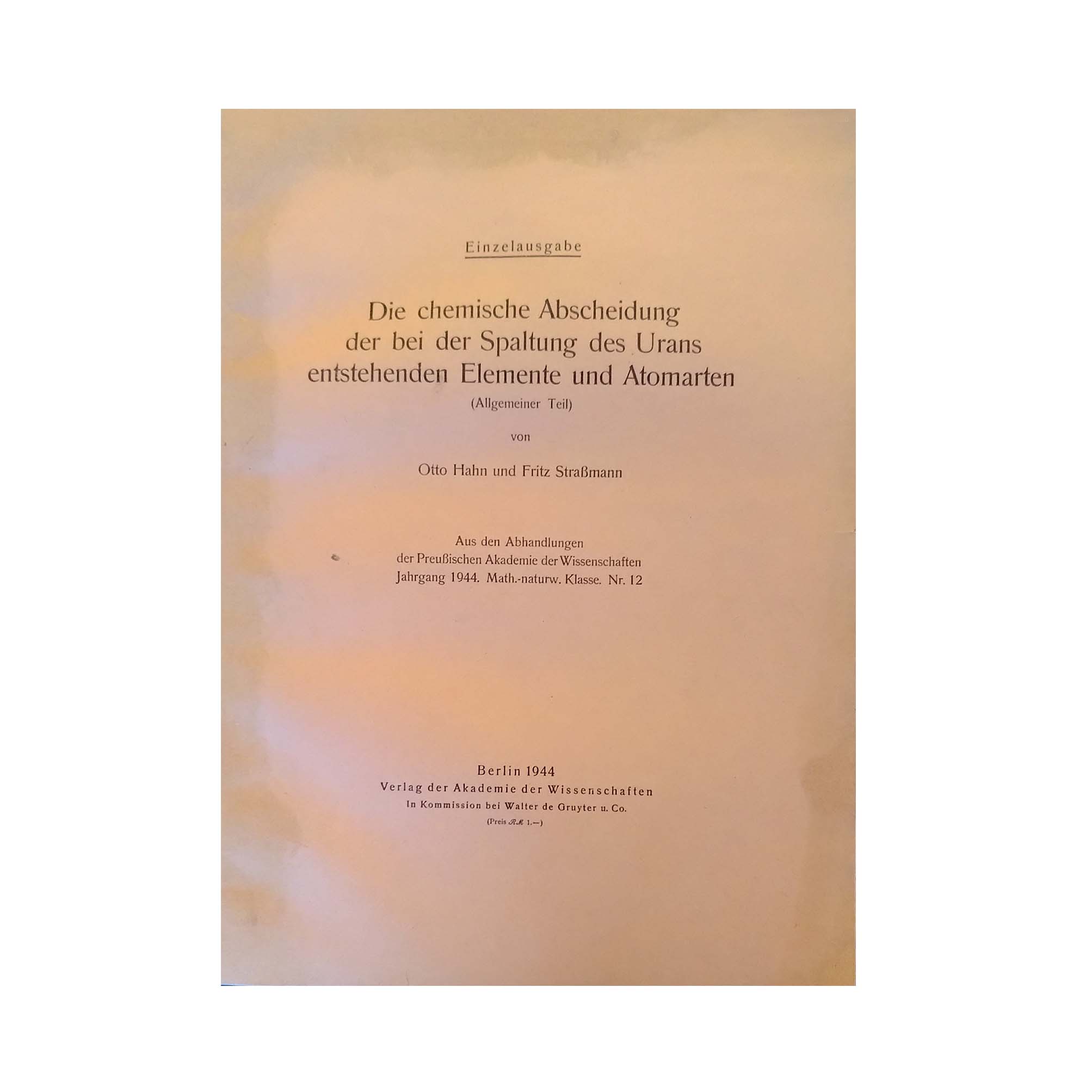First separate printing of the 2nd addendum to Hahn’s and Strassmann’s fundamental paper on nuclear fission, 1944
€ 800
O. HAHN, F. STRASSMANN and H. GÖTTE: DIE CHEMISCHE ABSCHEIDUNG DER BEI DER SPALTUNG DES URANS ENTSTEHENDEN ELEMENTE UND ATOMARTEN. Berlin: 1944.
Otto HAHN, Fritz STRASSMANN and Hans GÖTTE: DIE CHEMISCHE ABSCHEIDUNG DER BEI DER SPALTUNG DES URANS ENTSTEHENDEN ELEMENTE UND ATOMARTEN (Allgemeiner Teil). Aus den Abhandlungen der Preussischen Akademie der Wissenschaften. Jahrgang 1944. Math.-naturw. Klasse. Nr. 12. With 1 cliché text illustrations after ink drawings. Berlin: Verlag der Akademie der Wissenschaften (in commission at Walter de Gruyter [Reichsdruckerei]), 21st Dec. 1944.
29,8:21,3 cm. 14 pages. Letterpress on machine paper, in original publisher’s brochure on orange stock with black title printing on front cover and spine (list of „Sonderausgaben“ for sale).
First separate printing in the original wrappers of this 2nd and last supplement of a „fundamental paper on nuclear fission which eventually lead to the creation of the atomic bomb.“ (Dibner)
Authors, Contents, Edition: The German radio and nuclear chemists Otto Hahn and Fritz Straßmann "bombarding uranium with neutrons (as indicated by Fermi in the mid-1930s), found that treating the bombarded uranium with barium resulted in some strongly radioactive material. By late 1938 they suspected that uranium fission had occurred.“ These epochal findings had been presented by Hahn and Straßmann to the Prussian Academy on May 25th 1939. Their paper indicates in detail „fission of the uranium nucleus into two parts of about equal size with the release of much energy.“
If the 1st paper from 1939 („Über das Zerplatzen des Urankernes durch langsame Neutronen.“) contains the first comprehensive description of this core nuclear achievement, the following two corresponding papers published by Hahn and Straßmann with support by chemist Hans Götte during the Second World War in 1942 („Einiges über die experimentelle Entwirrung der bei der Spaltung des Urans auftretenden Elemente und Atomarten.“) and the present of 1944 describe experiments to identify the fission fragments.
Alongside the aforementioned an Austrian woman scientist of Jewish descent, Lise Meitner, colleague of the authors at the Berlin Kaiser-Wilhelm-Institute of Chemistry for decades, also contributed heavily to their findings. Meitner had to flee Nazi Germany in 1938 but continued her research in exile, e.g. in Copenhagen, where she worked in the laboratory of Niels Bohr. "Through Bohr and Fermi this nuclear energy was to become a reality in the atomic pile and the bomb blasts of 1945 as well as in the nuclear power stations of the following decades. Hahn received the Nobel Prize for Chemistry in 1944, and together with Meitner and Strassmann, the Fermi award in 1966.“ (All quotes Dibner).
Condition: Front cover and spine professionally restored, paper slightly wavy, otherwise well preserved copy indeed.
Reference: Dibner, Heralds of Science, 168; Norman 963 (paper 1 only); Poggendorff VIIa/2, 355; Scheld 191.
Additional information
| Weight | 1 kg |
|---|

